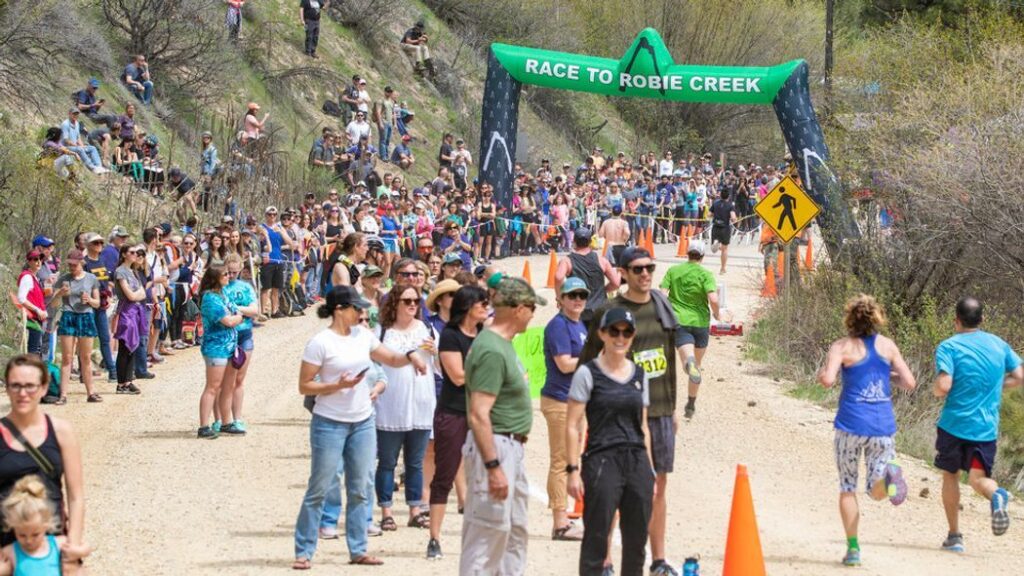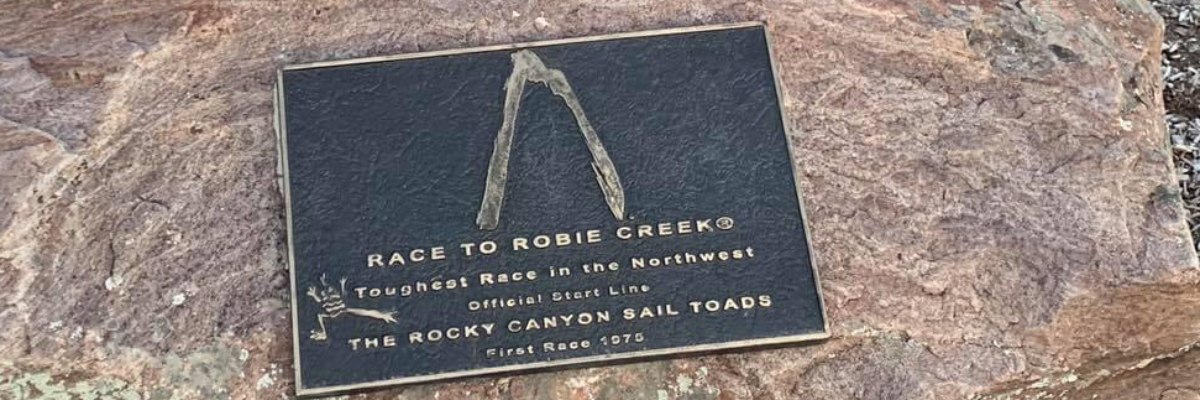How to Train for the Race to Robie Creek: 10 Questions Answered
Most people aren’t thinking too much about training for the Race to Robie Creek quite yet.
And I get it.
It’s early February right now, there’s snow on the ground, and it’s cold. The weather forecast shows we might even hit the single digits for a low this week.
Not exactly ideal running conditions.
But that doesn’t change the fact that the Race to Robie Creek is just a little over two months away! If you’re planning to run it, now is the time to start training.
Let me briefly introduce myself: I am NOT Dr. Maria Leibler, physical therapist and running rehab specialist. I’m Jason Leibler, her husband.
Maria normally writes these blog posts, but she was short on time this week, so we did something a little different.
I played the role of a reporter and “interviewed” her. I tried to extract as much useful info as I could for us non PT’s about how to train for the Race to Robie Creek.
Here’s what I learned:
TL;DR: How to Train for the Race to Robie Creek
The Race to Robie Creek is no ordinary half marathon—it’s a brutal uphill grind followed by a steep descent. To survive (and maybe even enjoy) it, focus on:
- Hill training. Your calves, quads, and lungs will thank you.
- Strength work. Especially for your calves, glutes, and quads.
- Fueling properly. Robie takes a lot more energy than a normal half.
- Downhill technique. Bombing the descent = knee pain. Control your form.
- Strategic tapering. Strength training should back off as mileage peaks.
- Smart recovery. Eat, sleep, and move well post-race.
Now, let’s get to the 10 questions.

10 Essential Questions About Training for the Race to Robie Creek
1. What makes Robie Creek different from a regular half marathon?
Maria: “Running uphill for such an extended period requires significantly more energy than covering the same distance on flat or rolling terrain. You need to adjust your fueling strategy accordingly and make sure you’ve trained on similar elevation profiles beforehand. My advice is to give it your all on the uphill portion because you can use the backside descent to your advantage.”
2. Are there any unique considerations about the Robie Creek course?
Maria: “The sun exposure is primarily on your right side during the climb, so plan your sun protection accordingly. If it’s been a snowy winter, be prepared for varying footing conditions on the backside of the mountain. Also, don’t neglect your upper body strength training – a strong upper body and core help maintain efficient form while climbing and provide better control during the descent.”
3. How do steep climbs affect our legs and joints?
Maria: “Steep climbs primarily put increased demands on your calf muscles. While running uphill engages multiple muscle groups, the calves take on a significantly larger workload compared to running on flat terrain. This is why specific hill training and calf strengthening become crucial when preparing for races with substantial elevation gain.”
4. How should runners prepare their muscles for the long uphill?
Maria: “The key to preparing for long uphill sections is consistent, progressive training. You should incorporate hill workouts at least once a week, starting with easier runs and gradually increasing the intensity. Additionally, complementing your hill training with targeted strength work in the gym is essential for building the muscular endurance needed for sustained climbs.”
5. What are the best strength exercises for hill running?
Maria: “The most effective exercises for hill running include step-ups, Romanian deadlifts, calf raises, squats, and Bulgarian split squats. When it comes to programming these exercises, focus on building true strength rather than endurance. This means using heavier weights with sets of 8-10 repetitions, leaving only 1-2 reps in reserve. You’re aiming to build muscular strength, not muscular endurance.”
6. How should runners structure their strength training?
Maria: “If you’re lifting heavy enough, you don’t need a huge variety of exercises in each session. Pick about four key exercises and perform them with proper intensity. It’s important to vary your movement patterns from week to week rather than doing the exact same routine. Most runners benefit from strength training twice a week.”
7. Why do runners often get knee or shin pain after long downhills?
Maria: “Most downhill-related knee pain occurs when runners over-stride and ‘bomb’ down the hill with excessive step length. The key is maintaining control of your movement and keeping your step length appropriate. Strong quadriceps are crucial as they act as your primary braking force when running downhill. When properly trained, they can help absorb and manage the increased forces that come with downhill running.”
8. What are common downhill running mistakes?
Maria: “The biggest mistake is not treating downhill running as a skill that requires specific training. Many runners assume running downhill is easy and therefore don’t develop proper technique or strategy. This lack of preparation often leads to poor form and increased injury risk. Downhill running needs to be practiced progressively, starting on gentle gradients before tackling steeper descents.”
9. How should runners adjust their training as race day approaches?
Maria: “As you approach race day, recovery becomes increasingly important. You need to sleep more than you think you need and increase your fueling to match your increased mileage. It’s also important to begin tapering your strength training as your running volume increases. Remember that you can’t just keep adding training load – as one aspect increases, something else needs to give. Consistency in recovery strategies is crucial.”
10. What’s the best way to recover after finishing the race?
Maria: “The immediate post-race period is crucial for recovery. Focus on proper fueling by ingesting calories to replenish the energy you’ve expended during the race – eat soon and eat plenty. Avoid doing anything too strenuous and give your body adequate time to recover before returning to running. Light walking can help promote blood flow and aid recovery.”
Tactical Training Tips: Where to Train in Boise
If trails are muddy and off-limits, you can still get quality hill training in. Local runners recommend:
-8th Street & Rocky Canyon – Reliable year-round roads with plenty of elevation.
-Cartwright Road – Climb from either Pierce Park or Bogus Basin Rd.
-Shaw Mountain Road – Another solid option for sustained climbing.
-Blacks Creek Road & Wilson Creek (Nampa) – Good alternatives with rolling hills.
-Hill Repeats – Short, steep climbs (e.g., Phillippi Hill) can simulate the effort.
-Part of the Actual Course – Get familiar with the first few miles.
–Boise Area Runners Group – Hosts Robie training runs starting in February.
For more runner-recommended training spots, check out [this Reddit discussion].
Final Thoughts
The Race to Robie Creek is brutal, but if you train smart, you’ll show up ready to take it on.
Stay consistent, listen to your body, and train safely.
And if you have any questions—or need help with an injury—shoot us an email or message us on Instagram.
Good luck with your training!

